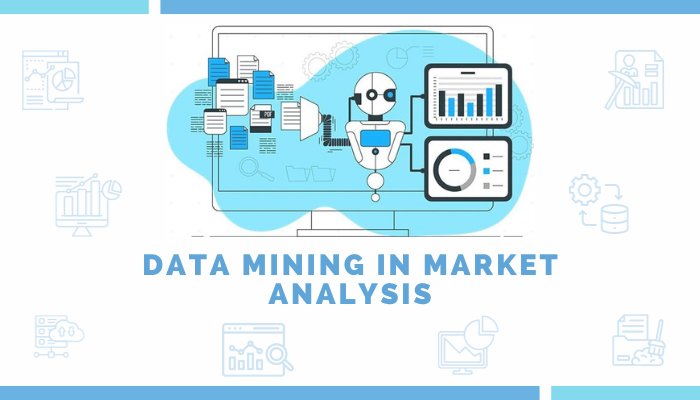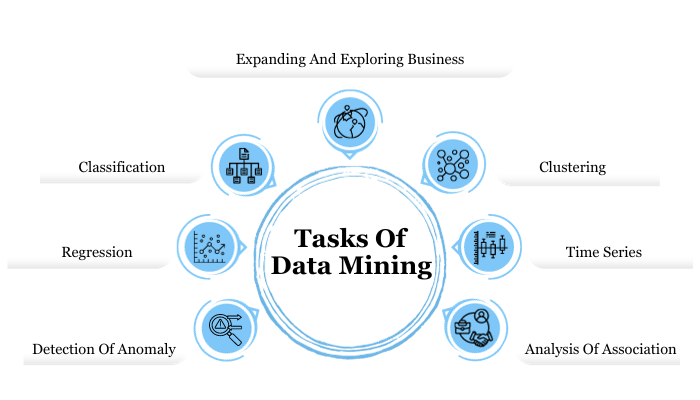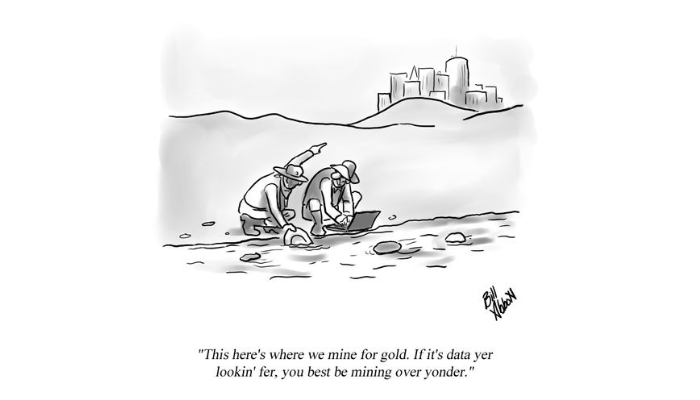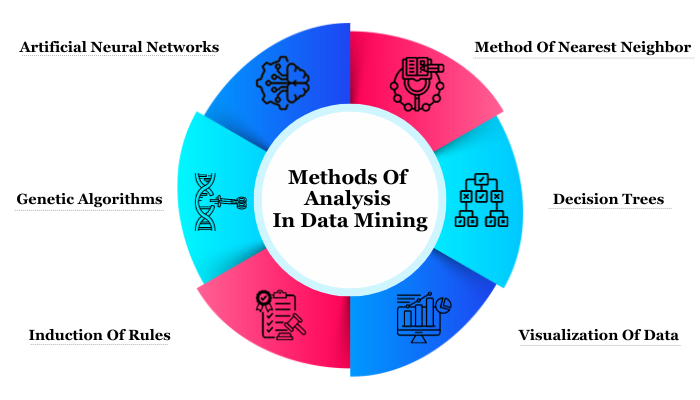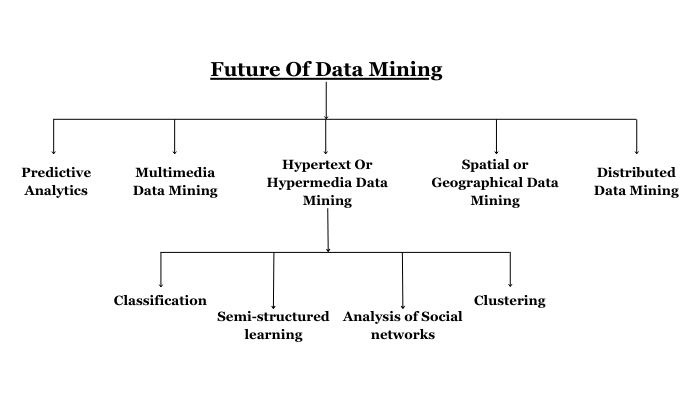The modern generation of the 21st century witnessed a massive growth of businesses and companies around the globe. Every other day you would find a business lifting its head into existence. The arrival of so many businesses together leveled up the game of the competition. The competition is for the sense of existence in the market. One of the major technologies that gained immense popularity and is growing rapidly among businesses is Data mining.
Data mining technology assists the various companies to look into the compilation of huge quantities of data they brought together and use them to develop collaboration and improve relationships to boost its efficiency. It helps them gather accurate and detailed information about customers, which helps them strategize an influential plan and make better decisions.
Let us first understand what Data Mining is before we delve deep into the case studies in data mining applications or the various data mining case study examples.
What Is Data Mining?
Data mining is a mechanical tool used by companies that helps extract all the information from a compilation of data. Such information helps in making predictions and acting as per the same. Various statistical and mathematical calculations are used to remove the cover from relations and trends among the huge quantities of data stored in the company database. Data mining is a perfect combination of statistics, data warehousing, artificial intelligence technology, and machine learning.
Statistics resembled the starting point of data mining. Regression analysis, standard deviation, and variance are the statistical functions that act as tools in facilitating people’s study of relationships between data and their reliability. Statistics is one of the pillars of data mining technology, as most data mining actions function according to it.
Data warehouses saw their birth in the 1970s when they used large mainframe systems and the COBOL techniques of programming to store data. All these saw the arrival of big databases that we now know as data warehouses. These warehouses are for the management, retrieval, and storage of data. Megabytes and terabytes of data get data management systems reflecting sophistication. Such storage is an integral part of data mining as it helps the company to manipulate organized data.
Artificial intelligence is another basic pillar of data mining like data warehouses and statistics. The beginning of artificial intelligence in the 1980s gave a set of algorithms with a design to help the computer learn by itself. The passage of time helped massive development that led to algorithms becoming data manipulation tools, with applications in large sets of data.
Data mining collaborated with artificial intelligence instead of applying an early-defined hypothesis that helped generate relationships between the data. Artificial intelligence helped analyze the data and find collaborations between the data, thus developing models to help the developers assume diverse relationships.
Artificial intelligence paved the way for machine learning. Experts define machine learning as the machine’s capability to improve its performance after assessing its earlier results. Machine learning comes right after artificial intelligence as it works towards bringing together the study of trial and error with the help of statistical analysis. It provides an opportunity for the software to learn things by itself and makes all the data without any external help.
Tasks Of Data Mining
Classification
Classification refers to a procedure of finding out a model that explains the classes and concepts of data. The primary objective of classification is to predict the class objects whose identities are still behind the curtain. This derivation of this model works on the analytical results of the training sets of data.
You can understand it better with the following example;
- Political parties are assigning the voters in their known buckets.
- Including new customers into an existing customer group.
Regression
When we talk about statistical modeling, regression analysis comes first in discussion. It refers to a statistical process for estimating the relationship among the diverse variables. Regression comes with a lot of analyzing and modeling techniques for many variables. Here the spotlight is on the relationship between a dependent variable and one or more than one independent variable.
Following are some examples;
- Predictions concerning the unemployment rates for the following year.
- Making estimates about the insurance premium.
Detection Of Anomaly
Anomalies refer to the problems and issues within the software. This is a process of identifying the events, items, or observations that do not fall in line with the patterns or items expected in the dataset.
Example: Fraud transactions in your credit card account.
Time Series
A time series refers to a series of data points that are in a list, graph, or index, depending on the order of time. Commonly speaking, time-series signifies the action sequence taken along successive points of time, placed at regular intervals. Therefore, it is a discrete sequence of data.
Example: Production forecasting, forecasting of sales, etc.
Clustering
Clustering refers to sorting the objects into diverse groups, where each group would consist of objects having similar characteristics. The features of the objects in one group will differ from the objects in another group. Following is a static example of clustering;
- Searching the customer segments in a company, depending on their transactions, customer calls, and web.
Analysis Of Association
Association is one of those data mining functions that finds out the possibility of an item recurring while in a collection. Association rules explain the rules of relationship between the items that co-occur.
Example: Search for the various opportunities for cross-selling for a retailer, as per his transaction history.
Expanding And Exploring Business
As we already know, data mining refers to a process in businesses where large chunks of data get explored to find meaningful rules and patterns. Companies can use data mining to gain that competitive edge over their fellow companies and push their business to better heights.
History Of Data Mining
You might feel that data mining is a new concept. This term might be a new one, but the concept has been around for quite a few years. Classical statistics, artificial intelligence, and machine learning together led to the development of data mining. Everything began in the 1960s when the concept of data collection surfaced. It refers to the storage of data and information in computers. Tapes, disks, and computers were the technology available during that time.
Next, we saw the arrival of the concept of Data access in the 1980s. The concept of data access brought the introduction of relational databases and structured languages for the query. Both these helped in educating us humans more about data. Dynamic availability of data at a record level came with Data access.
Decision reports and Data warehousing came in the 1990s, which unveiled the procedure of management and retrieval of centralized data. This came with the following characteristics;
- Maintenance of a central address for keeping all the data concerning the organization.
- It will help you in analyzing the data and concentrating on the specific characteristics.
- Dynamic delivery of data at multiple levels.
The present data mining is all about making predictions and generalizing the patterns.
Influential Events And Personalities In Data Mining
Data mining saw the inception of its mention in the hands of John Herry Holland in 1975, who wrote the book “Adaptation in Natural and Artificial Systems.” This book was a thesis on genetic algorithms. However, the term “Data Mining” came into the limelight in the 1990s, with its mention in the database community for the first time. Moving further, William S . Cleveland brought forward Data mining as an independent concept in 2001. Data mining gained its epitome of prominence in February 2015, when The White House of the United States Of America hired D.J. Patil as their data scientist.
Methods Of Analysis In Data Mining
There are different methods of analytical observation in Data mining. They are as follows;
Artificial Neural Networks
These are the non-linear models of prediction that have a stark resemblance with the neural networks in biology when it comes to structuring.
Genetic Algorithms
Genetic algorithms refer to optimizing that utilizes the combination of genetics, natural selection, and mutation based on the concept of natural evolution.
Induction Of Rules
The application of all the rules found via extraction is the ones found from the significance of statistics.
Decision Trees
These are structures with the shape of trees that help in showing a set of decisions. These decisions help in generating rules for classifying a dataset.
- Chi-square Automatic Interaction Detection (CHAID), Classification and Regression Trees (CART).
- Classification and Regression tree works towards segmentation of the dataset by creating a spill that goes two ways.
- Chi-square Automatic Interaction Detection uses the chi-square tests to create splits in multiple directions.
Method Of Nearest Neighbour
The nearest neighbor technique works towards classifying each record within a dataset. It depends on combining the classes of the k-records that have the highest similarity with the dataset. (K=1)
Visualization Of Data
- Data visualization refers to the interpretation of complex relationships via visuals within data with multi-dimensions.
- One of the substantial examples is the usage of graphical tools for the illustration purposes of data relationships.
Also Read: Top 10 Data Mining Techniques for Business Success
Application Of Data Mining
You can establish data mining for your company via the feature of modeling. Modeling refers to the act of building a model that has an application to a particular situation, following which you can use that model in a different situation that does not have any existing model. Such models help you in making predictions regarding the patterns.
Data Mining In The Field Of Marketing
Companies garnered huge benefits and returns in their marketing area when considering data mining and working on its advancement. Companies use all the data gathered via data mining to push their efforts towards tailoring their discount coupons, and gift vouchers and working on their sales and advertisements to target their customers.
When you devise your marketing strategy through such mined data, you can devise a better marketing strategy and increase your sales effectiveness. Your company will also save a lot of money depending on such information.
Case Studies On Data Mining
Let us now go through the various case studies of data mining applications that will help us understand the importance of this procedure in various companies and businesses;
Case Study No.1: Target
The first data mining case study example is that of the company named ‘Target.’ Target vouchers use data mining for tailoring their discount coupons. They hope that sending such discount coupons to the customers will make them buy their products regularly. The strategists of Target assume this as an effective mechanism to prevent the customers from changing their loyalties to other brands or companies.
- When most customers are vulnerable to changing brand loyalties, due to varied choices and changing preferences. Like in tech sphere, innovative features like longer battery life and a more advanced camera system can be some factors.
- The stores like Target try to utilize such time to exploit the opportunity and lure customers into making purchases from their brand. Not just temporarily, but they try to engage them till the very end.
The company puts all its data into useful, which they collect while you are in its store for purchase or on its online website for buying something. They also collect such data by purchasing it from other companies. Duhigg states that Target has been collecting data for decades through the customers who walk into their stores regularly. They assign distinctive, unique codes to diverse customers from time to time.
This unique code is the Guest ID number within the working of Target, which keeps track of everything they purchase. Later, they use this very data to analyze the tastes and preferences of the customers and take effective steps to boost their marketing strategy.
Andrew Pole, an analyst, started his analysis of the “Pregnancy prediction model” by going through the history of the company’s baby shower registry. He tried to use this data to predict a woman’s changes regarding their shopping habits when they are expecting a baby. He formulated a list of 25 items based on this information to determine whether a woman is pregnant or not. This model successfully predicted whether a customer was pregnant or not but also assumed the date of delivery.
Case Study No.2: Amazon
Here we are going to talk about Amazon. The case study of Amazon is one of the best case studies on data mining in market analysis. Amazon tries to use all the data they mined so that they can improve their customer service. The data mined consists of the customer’s name, home address, and personal details. Such data also consists of the customer’s preferences and the issues they are dealing with to find a solution.
They try to collect all the data regarding the customer from the various departments of the firm. Once they have all the necessary data, they synchronize and compile them for sending them to the human representative. The human representative then uses the data to have a great personalized conversation with the particular customer.
The employees of the customer service department of Amazon have all such needful information in their hands. This adds to making the conversation with the customer a lot more convenient. The employees of customer service have enough information about you which helps them make the conversation personal. However, there are no worries about the conversation being creepy.
Also check: Amazon AWS data partner marketplace.
Case Study No.3: Starbucks
Starbucks is one of the leading coffee shops with innumerable branches around the globe. Their case study will be a perfect example of the case studies on data mining in market analysis. Starbucks indulges in data mining to determine the perfect locations for setting up its stores. Tactics of Data mining and modeling assist the numerous Starbucks locations within proximity.
They try to analyze the data based on the locations, the population composition of the location, and traffic in the streets around to predict whether setting up a store there will be successful or not. Starbucks seeks assistance from a data platform named ArcGIS, developed by a company named Esri. They help them gather all the necessary information about the concerned location, demographic structure, the presence of Customer homes around, work, and other outings. All these data supplement the monitoring and boosting of their sales.
This particular company named Esri gathers a lot of data from Starbucks and, after ingrained analysis, positions them on platforms that are easily understandable for the employees there.
Case Study No.4: Usage Of Association Rule Mining In the Systems Of Recommendation
Recommender systems gained immense popularity among various fields of the industry at the current time. Music, movies, books, search queries, research books, social tags, etc., are widely-known fields. These recommendation systems assist enterprises by combining ideas from intelligent systems, information retrieval, and machine learning to make assumptions regarding the customer’s behavior. Recommender systems have two distinct approaches for their functioning;
Collaborative Filtering
The method of collaborative filtering indulges in collecting and analyzing a huge chunk of information regarding the user’s preferences, behavior, activities, etc. this will help them predict the like of a user in accordance with the other users. One of the approaches here is the usage of the Apriori algorithm.
Here you would know how the Apriori algorithm is used to squeeze out data concerning association rules from the user profiles. PVT is one of the prominent examples in this regard. PVT is one of those recommender systems that recommend various TV channels to the viewers, depending on their viewing experience. Channels with both positive and negative reviews work under the management of PVT. It treats TV viewers as transactions and the program ratings as itemsets.
One can use the Apriori algorithm to find out a set of rules and attached confidence levels between the programs. The confidence values resemble the similarity scores, and the system uses them to fill a program similarity matrix. There is an initiative to create a bridge between two TV shows. One who watches Splitsville or Roadies will not take an interest in shows like Kaun Banega Crorepati. However, if there is a line drawn between MTV Spitsvilla and Kaun Banega Crorepati, it will result in pattern watching.
Case Study No. 5: Model Of Classification For Selection of Targets In Direct Marketing
Historical data of purchase helped develop a prediction model of response along with data mining techniques. This development was to make predictions about whether a customer of the Ebedi Microfinance Bank of Nigeria would revert to a promotional offer or not. Data mining techniques helped develop a prediction model with the help of data regarding the customer’s purchase history. The data found its storage in a data warehouse to assist the decision of the management. The customer’s purchases in history and his demographic dataset helped in formulating a response model.
Then the development of the model took inputs from the following purchase variables;
Recent Purchases
It refers to the number of months from the time of the first purchase till the time the customer made the last purchase. It is one of the most powerful weapons to predict whether the promotional offer will succeed or fail. It is quite a logical observation. The primary statement through this point is that if you made some recent purchases, you are more likely to respond to the offer as against the fact that your last purchase was way back.
Frequency
Frequency stands for the number of purchases the customer made. This data concerning the number of purchases can be within a definite period or all the purchases to date. This characteristic feature comes second to the factor of recent purchases when it comes to making predictions.
Monetary value
Monetary value resembles the total amount spent by the customer on making purchases from the company. You can draw some resemblance with frequency as such data can have a definite period or the total money spent to date. It is the least favorable tool to predict the steps of the customer.
However, when all three characteristic tools come together, it can sharpen the chances of the prediction being correct.
The customer’s demographic information includes his features and details concerning his sex, postal address, age, occupation, etc. The Bayesian algorithm, rather than the Naïve Bayesian algorithm, was a primary ingredient in constructing the classifier system. The selection techniques of both wrapper and filter features were in an application for selecting the inputs of this model.
The data results revealed that the Ebedi Microfinance Bank of Nigeria could plan effective strategies for marketing their goods and services. They can do it by making a detailed report on the status of customers that will guide their path to making correct decisions regarding the disbursement of funds. Therefore, they can use those funds on useful marketing tactics rather than waste them on failed strategies.
Read More: Case Study: Walmart
The Future Of Data Mining
You can perceive the future of data mining through the following characteristics;
Predictive Analytics
Predictive analytics states that you can achieve “one-click data mining” through a simple and more efficient data mining process.
- You should allow the application of advanced analytics across various subjects.
- The area that will bring the highest revolution will be medicine. The researchers can analyze prediction to determine the factors associated with a particular disease and what medicine might work wonders on the affected patient.
Distributed Data Mining
Distributed data mining refers to the act of mining data spread across different locations.
Combine the facilities of local data analysis and a global data model to get the best results out of data mining.
Hypertext Or Hypermedia Data Mining
This type of data mining includes hyperlinks, texts, marked texts, and any other form of information related to hypermedia. It has the following techniques;
- Classification.
- Clustering.
- Semi-structured learning.
- Analysis of Social Networks.
Multimedia Data Mining
The data from Multimedia data mining includes multimedia like videos, images, animation, audio, etc. This form of data requires a separate representation compared to traditional data.
Spatial or Geographical Data Mining
Data mining consisting of space or geography includes the analytical information concerning satellite images, natural resources, and all data from topography.
All of the data comes from diverse locations, with most of them being pictures.
Things That Bother About Data Mining
There are a few drawbacks or rather concerns that experts have regarding data mining. They are as follows;
Assurance Of Privacy
Data mining is gaining immense popularity and momentum among various industries. This results in the collection of more information about every individual. When such accurate and personal information comes to the public domain, the chances of exploitation increase by manifolds. Some people or applications can use this information to meet their narrow desires. So you can very well understand that data mining allows easy accessibility of data, thus exposing it to the ills of exploitation. People can steal your identity and use it to fraud someone else.
Issues With User Interface
The experts dealing with data mining studies are skeptical about whether visualization tools can expose the true knowledge any data holds. The chances of people understanding any visual data and discovering the true meaning are difficult at times.
Problems Concerning The Performance Of Data Mining
When we talk about data mining tools, numerous statistics, and other analytical methods had a design for discovering smaller quantities of data. Such tools might fail to accommodate the rising gravity and depth of information.
Trade-Off
There is no guarantee that the collection of data and its mining will mitigate the risks in the future. Therefore, data mining is still not a flawless procedure.
The above information can help you better understand data mining through the various case studies in data mining applications. Data mining can be a boon for various industries as that will help them secure more relevant information about the customers and boost all strategies for garnering better customer experiences.
When we talk about the few drawbacks of data mining, various companies’ advanced technology and software developments can mitigate the risks. Moreover, no company will sacrifice its brand name for the sake of some cheap benefits. You can get the best data solution services from http://bizprospex.com, which can help you with their AML Sanctions List, PEP List, Data Appending, and Skip Tracing services to gather the best and most authentic data available.
